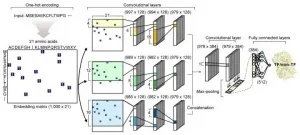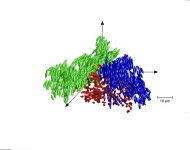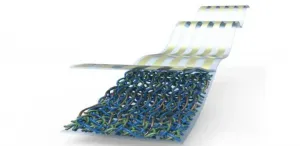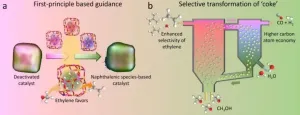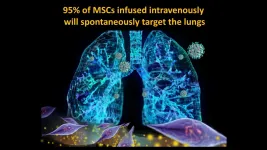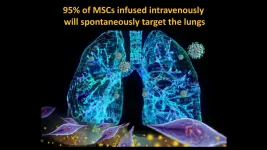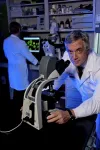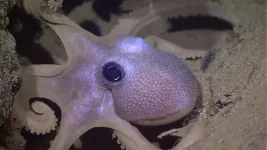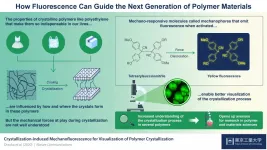New imaging method reveals if antibiotics reach bacteria hiding in tissues
2021-01-05
(Press-News.org) Researchers at the Francis Crick Institute and the University of Western Australia have developed a new imaging method to see where antibiotics have reached bacteria within tissues. The method could be used to help develop more effective antibiotic treatments, reducing the risk of antibiotic resistance.
During bacterial infections like tuberculosis, bacteria enter human cells, which poses a challenge for treatment, as antibiotics must reach and enter all infected cells in order to be effective. If researchers could select for or develop more effective antibiotics based on where they reach, this may reduce the length of treatment needed, which in turn could reduce the risk of antibiotic resistance developing.
In their study, published in PLoS Biology the researchers developed a new imaging method to see where in infected tissues and in cells an antibiotic given to treat tuberculosis reaches the bacteria. The scientists are continuing to work on the method, adapting it for other types of antibiotic and to image multiple antibiotics at the same time.
Max Gutierrez, author and group leader of the Host-Pathogen Interactions in Tuberculosis Laboratory at the Crick, says: "In the case of tuberculosis, people need to be treated with at least three different antibiotics over six months. We don't yet fully understand why this extended treatment is needed. We hope that being able to more clearly see where antibiotics are going, will help us better understand this process and find ways to improve it."
To develop the imaging method, called CLEIMiT,* the researcher analysed lung tissue from mice infected with tuberculosis and treated with the antibiotic bedaquiline.
They combined a variety of imaging methods, including confocal laser scanning microscopy, 3D fluorescence microscopy, electron microscopy and nanoscale secondary ion mass spectrometry, to develop their new approach.
Using this method, they found that bedaquiline had not reached all infected cells in the lung tissue and also had not entered all infected areas within infected cells.
They also found this antibiotic was collecting in macrophages and in polymorphonuclear cells, both types of immune cell. This was a surprise as these cells have different environments and it wasn't thought that one antibiotic would be able to enter both.
Tony Fearns, author and senior laboratory research scientist in the Host-Pathogen Interactions in Tuberculosis Laboratory at the Crick, says: "Our approach could be used to help develop new antibiotics or to re-assess current antibiotics to judge how effectively they reach their targets. The more we learn about how drugs behave in the body, for example where they collect, the better we will be able to treat bacterial diseases like tuberculosis."
INFORMATION:
Notes to Editors
Fearns, A. et al. (2020) Correlative Light Electron Ion Microscopy reveal in vivo localisation of bedaquiline in Mycobacterium tuberculosis infected lungs. PLoS Biology. DOI
*CLEMiT stands for: Correlative light, electron and ion microscopy in tissue
The Francis Crick Institute is a biomedical discovery institute dedicated to understanding the fundamental biology underlying health and disease. Its work is helping to understand why disease develops and to translate discoveries into new ways to prevent, diagnose and treat illnesses such as cancer, heart disease, stroke, infections, and neurodegenerative diseases.
An independent organisation, its founding partners are the Medical Research Council (MRC), Cancer Research UK, Wellcome, UCL (University College London), Imperial College London and King's College London.
The Crick was formed in 2015, and in 2016 it moved into a brand new state-of-the-art building in central London which brings together 1500 scientists and support staff working collaboratively across disciplines, making it the biggest biomedical research facility under a single roof in Europe.
http://crick.ac.uk/
ELSE PRESS RELEASES FROM THIS DATE:
2021-01-05
A joint research team from KAIST and UCSD has developed a deep neural network named DeepTFactor that predicts transcription factors from protein sequences. DeepTFactor will serve as a useful tool for understanding the regulatory systems of organisms, accelerating the use of deep learning for solving biological problems.
A transcription factor is a protein that specifically binds to DNA sequences to control the transcription initiation. Analyzing transcriptional regulation enables the understanding of how organisms control gene expression in response to genetic or environmental changes. In this regard, finding the transcription factor of an organism is the first step in the analysis ...
2021-01-05
While glass is a truly ubiquitous material that we use on a daily basis, it also represents a major scientific conundrum. Contrary to what one might expect, the true nature of glass remains something of a mystery, with scientific inquiry into its chemical and physical properties still underway. In chemistry and physics, the term glass itself is a mutable concept: It includes the substance we know as window glass, but it may also refer to a range of other materials with properties that can be explained by reference to glass-like behaviour, including, for instance, ...
2021-01-05
Sunlight offers a potential solution in the search for an energy source that does not harm the planet, but this depends on finding a way to efficiently turn electromagnetic energy into electricity. Researchers from KAUST have shown how a known herbicide can improve this conversion in organic devices.
While solar cells have traditionally been made from inorganic materials such as silicon, organic materials are starting to break through as an alternative because they are light, flexible and relatively inexpensive to make, even offering the possibility for ...
2021-01-05
MTO process, which was first commercialized in 2010, is a catalytic process converting methanol, which is typically made from coal, natural gas, biomass, and CO2, over SAPO-34 zeolite catalyst. It's becoming one of the main streams for producing light olefins, including ethylene and propylene, from non-oil resources.
One of the major challenges in MTO is the rapid deactivation of zeolite catalyst due to the coke deposition.
In industrial practices, a fluidized bed reactor-regenerator configuration is normally used in order to maintain the continuous operation, in ...
2021-01-05
Dr. Camilo Ricordi, director of the Diabetes Research Institute (DRI) and Cell Transplant Center at the University of Miami Miller School of Medicine, and his team of international collaborators are reporting the results of a groundbreaking randomized controlled trial showing umbilical cord-derived mesenchymal stem cell (UC-MSC) infusions safely reduce risk of death and quicken time to recovery for the most severe COVID-19 patients. Dr. Ricordi's peer-reviewed paper has just been published in STEM CELLS Translational Medicine (SCTM) January 2021.
The clinical trial, authorized by the FDA last ...
2021-01-05
Dr. Camilo Ricordi, director of the Diabetes Research Institute (DRI) and Cell Transplant Center at the University of Miami Miller School of Medicine, and his team of international collaborators are reporting the results of a groundbreaking randomized controlled trial showing umbilical cord-derived mesenchymal stem cell (UC-MSC) infusions safely reduce risk of death and quicken time to recovery for the most severe COVID-19 patients. Dr. Ricordi's peer-reviewed paper has just been published in STEM CELLS Translational Medicine (SCTM) January 2021.
The clinical trial, authorized by the FDA last April, was initiated by The Cure Alliance, a 501(c)(3) non-profit organization of research scientists founded ten years ago by Dr. Ricordi for scientists ...
2021-01-05
Like any other plant, Arabidopsis thaliana or mouse-ear cress, needs nitrogen to survive and thrive. But, like maize, beans and sugar beet, it prefers nitrogen in the form of nitrate, growing better on nitrate rich soil. Whereas, pine and rice for example preferentially grow on ammonium nutrition, another form of the key macronutrient nitrogen. If the concentration or the availability of the different forms of nitrogen fluctuate, plants have to adapt quickly. "One of the most important questions is, what is the role of plant hormones in adaptation to the nitrogen availability? How do the machineries within a plant cope with their changing environment?" asks Eva Benková, developmental biologist and Professor at the Institute of Science and Technology (IST) Austria.
Finding the balance
In ...
2021-01-05
University of Miami Miller School of Medicine researchers led a unique and groundbreaking randomized controlled trial showing umbilical cord derived mesenchymal stem cell infusions safely reduce risk of death and quicken time to recovery for the severest COVID-19 patients, according to results published in STEM CELLS Translational Medicine in January 2021.
The study's senior author, Camillo Ricordi, M.D., director of the Diabetes Research Institute (DRI) and Cell Transplant Center at the University of Miami Miller School of Medicine, said treating COVID-19 with mesenchymal stem cells makes sense.
Results: treatment group vs. ...
2021-01-05
Inspired by the color-changing skin of cuttlefish, octopuses and squids, Rutgers engineers have created a 3D-printed smart gel that changes shape when exposed to light, becomes "artificial muscle" and may lead to new military camouflage, soft robotics and flexible displays.
The engineers also developed a 3D-printed stretchy material that can reveal colors when light changes, according to their study in the journal ACS Applied Materials & Interfaces.
Their invention is modeled after the amazing ability of cephalopods such as cuttlefish, octopuses and squids to change the color and texture of their soft skin for camouflage and communication. This is achieved by the ...
2021-01-05
In modern times, manufacturers produce highly specialized materials for a wide array of uses, called polymers. Polymers have a variety of purposes owing to their versatile properties, ranging from being used in construction due to their high tensile strength and resistance to manufacturing plastic bags that require more lightweight, flexible materials, such as nylon or polyethene.
These differences between the properties of different polymers stems from their internal structure. Polymers are made up of long chains of smaller sub-units, called "monomers." Crystallization occurs when crystalline polymers are melted, then cooled down slowly, which enables the chains to organize themselves into neatly arranged ...
LAST 30 PRESS RELEASES:
[Press-News.org] New imaging method reveals if antibiotics reach bacteria hiding in tissues
